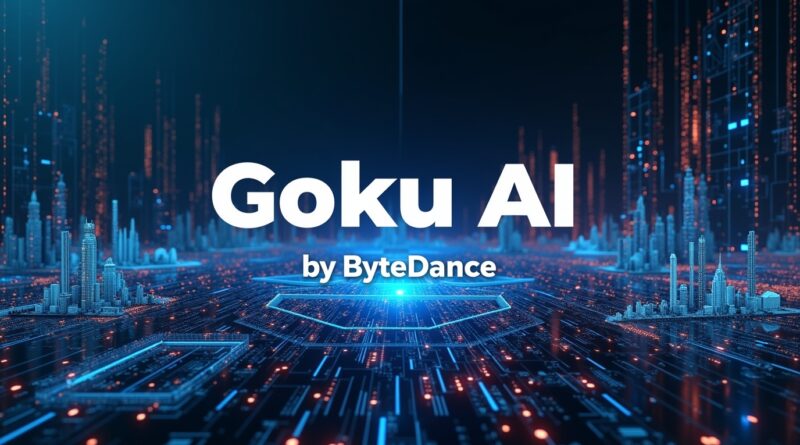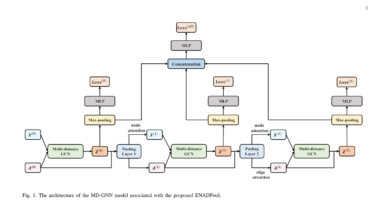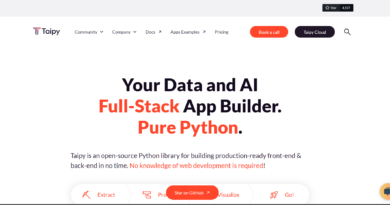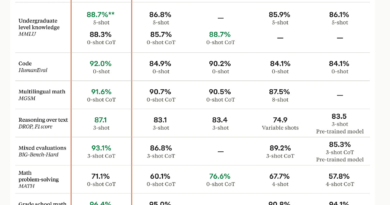ByteDance Unveils Goku: A Powerful AI Model Set to Compete with Google’s Luma and OpenAI’s Sora
The rapid evolution of AI-driven content creation has sparked a competitive race among tech giants to develop advanced image and video generation models. ByteDance, the parent company of TikTok, has entered the arena with the launch of Goku, a new family of AI models designed to generate high-quality product videos, lifelike human figures, and creative visual content. With this release, ByteDance aims to challenge industry leaders like Google’s Luma and OpenAI’s Sora by offering robust, versatile, and accessible AI tools for businesses and creators alike.
The Rise of AI Video Generation Models
AI models capable of generating videos from text and images have become indispensable tools for marketers, content creators, and developers. These models simplify the content creation process, reduce production costs, and open new creative possibilities. Google’s Luma and OpenAI’s Sora have set the bar high with their impressive generative capabilities. However, ByteDance’s Goku introduces several innovative features that could disrupt the status quo.
Goku focuses on providing businesses with the ability to create realistic product videos without professional actors, complex editing processes, or expensive production setups. This innovation democratizes video production, making it accessible to smaller businesses and independent creators.
What is ByteDance’s Goku Model?
Goku is a joint image-video generation model capable of producing high-quality videos with AI-generated influencers, marketing avatars, landscape demos, and even creative visualizations of abstract concepts like poetry. The model is named after the iconic anime character from the Dragon Ball series, symbolizing strength, adaptability, and intelligence.

ByteDance researchers have developed Goku with a clear goal: to simplify and enhance AI-driven content creation. The model can transform static images into dynamic videos, generate new scenes from text prompts, and seamlessly blend realistic and creative elements into a cohesive visual narrative.
Key Features and Innovations of Goku
- Rectified Flow (RF) Formulation:
Goku employs a rectified flow approach for joint image and video generation. This technique enhances the model’s ability to generate high-quality, coherent videos by ensuring a smooth, natural transition between frames. - 3D Joint Image-Video VAE:
The model uses a 3D Variational Autoencoder (VAE) to compress images and videos into a shared latent space. This architecture allows for efficient generation of both static and dynamic content from a single model. - Advanced Transformer Network:
Goku features a transformer architecture optimized with several performance-enhancing techniques:- FlashAttention: Reduces memory usage and accelerates training.
- Sequence Parallelism: Enables efficient processing of long sequences.
- Patch n’ Pack: Improves the handling of video frames for better quality.
- 3D RoPE Position Embedding: Enhances spatial understanding for more realistic outputs.
- Q-K Normalization: Stabilizes attention mechanisms to improve performance.
- AI-Generated Influencers and Avatars:
Goku can create lifelike human figures that serve as digital influencers or avatars in marketing videos. These AI-generated personas can demonstrate products, interact with audiences, and convey messages in a compelling, human-like manner. - Dynamic Visualizations:
The model can bring abstract concepts to life through creative animations. For instance, it can visualize Chinese poetry or simulate complex landscapes, expanding its use beyond marketing to education, entertainment, and art.
Performance and Benchmark Results of Goku
Goku has demonstrated exceptional performance across various benchmarks, outperforming some of its key competitors:
- GenEval Score: 0.76 – Reflecting the model’s ability to generate diverse and coherent video content.
- DPG-Bench (Text-to-Image): 83.65 – Highlighting its capability in static image generation.
- VBench (Text-to-Video): 84.85 – Indicating superior performance in video generation tasks.
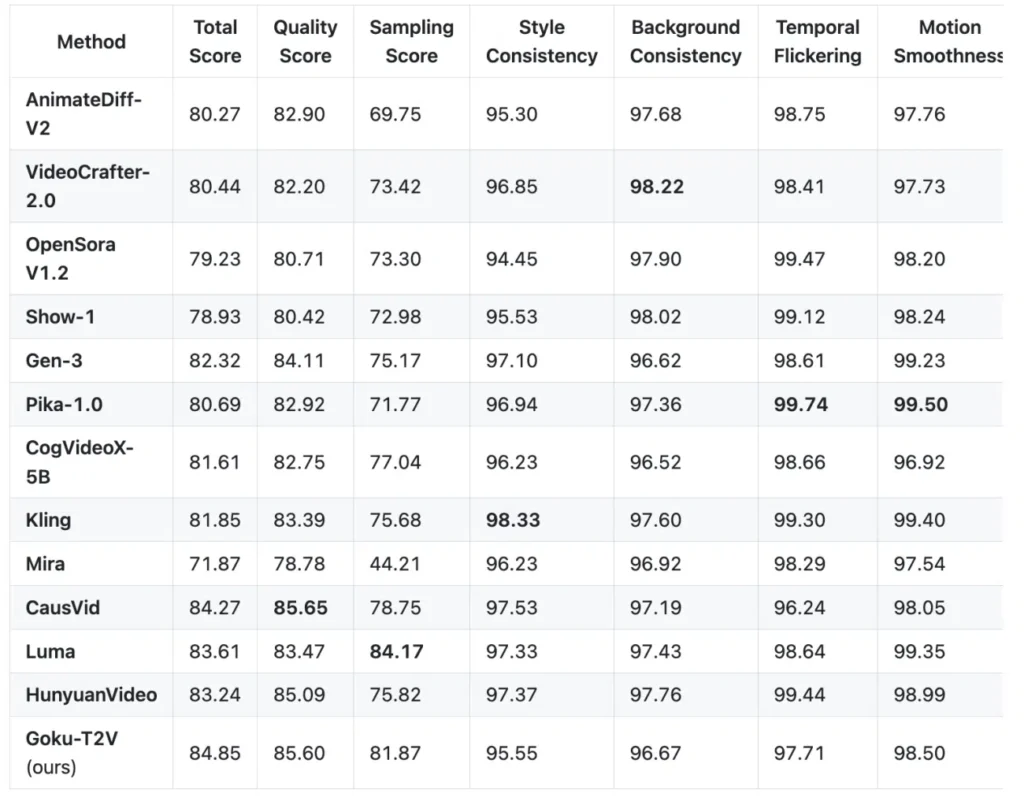
These results position Goku as a strong contender in the generative AI space, potentially challenging models like Luma, Sora, Mira, and Pika.
Applications and Use Cases of Goku
- Marketing and Advertising:
- Generate high-quality product videos without physical shoots.
- Create AI influencers to promote products across social media platforms.
- Develop engaging visual content for digital campaigns.
- Content Creation and Social Media:
- Produce eye-catching videos for platforms like TikTok and Instagram.
- Transform static posts into dynamic, shareable content.
- Education and Training:
- Create visual aids for educational content.
- Simulate historical events, scientific processes, or abstract ideas.
- Entertainment and Media Production:
- Generate trailers, concept art, and background visuals for games and movies.
- Experiment with new storytelling techniques using AI-generated characters and settings.
- E-commerce:
- Develop product demos featuring AI-generated models showcasing clothing, gadgets, or furniture.
- Create 360-degree product views and interactive videos.
Challenges and Considerations of Goku
While Goku presents significant advancements, it also raises concerns related to content authenticity and ethical AI usage. The model’s ability to generate lifelike human figures could be misused to create deepfakes or deceptive content. ByteDance has emphasized its commitment to responsible AI practices, including watermarking AI-generated videos and developing tools to detect misuse.
Additionally, the computational demands of training and running such models remain substantial. Despite optimization techniques like FlashAttention, businesses must consider the infrastructure requirements when integrating Goku into their workflows.
Goku vs. Google Luma and OpenAI Sora
Google’s Luma: Known for its efficient video generation and creative applications, Luma has established itself as a versatile tool for content creators. However, Goku’s joint image-video VAE and advanced transformer network give it an edge in generating more realistic and context-aware visuals.
OpenAI’s Sora: OpenAI’s model excels in generating imaginative and coherent videos from simple prompts. Goku, however, offers enhanced performance in commercial applications like product marketing and influencer videos, making it more business-friendly.
While Luma and Sora remain industry benchmarks, Goku’s innovative architecture and high benchmark scores suggest it can compete effectively in the AI video generation space.
The Road Ahead
ByteDance’s launch of Goku signifies a broader trend in the AI industry: the push toward more specialized, efficient, and accessible generative models. As competition intensifies, advancements in architecture, training efficiency, and application versatility will shape the future of AI-driven content creation.
With its promising performance metrics and innovative design, Goku has positioned itself as a formidable player in the image-video generation landscape. Whether it can maintain its momentum against tech giants like Google and OpenAI remains to be seen. However, one thing is clear: ByteDance is serious about redefining the future of AI-generated content.
Stay tuned as we continue to monitor the evolution of Goku and its impact on the generative AI ecosystem.
Do you have an incredible AI tool or app? Let’s make it shine! Contact us now to get featured and reach a wider audience.
Explore 4000+ latest AI tools at AI Toolhouse 🚀. Don’t forget to follow us on LinkedIn. Do join our active AI community on Discord.
Read our other blogs on LLMs 😁
If you like our work, you will love our Newsletter 📰

